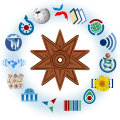Features
This wiki has many extensions installed and also other gadgets or configuration settings within the software that make it particularly interesting. Follow each link in the table below for more information. If your wiki doesn't have all these features, you should contact eQuality Technology for an upgrade.
| Page | Image | Description |
|---|---|---|
| Abuse Filter |  | Allows Admins (privileged users) to create filters which act upon edits automatically. |
| Bootstrap |  | A front-end web framework. Bootstrap allows you to easily create aesthetically pleasing layouts for your content. Bootstrap provides responsive, mobile-first front-end web development. It contains CSS- and JavaScript-based design templates for typography, forms, buttons, navigation, and other interface components. |
| CSS |  | Add custom CSS to pages or sitewide |
| Categories | The categories of articles in this Wiki, presented in a cloud. Relative size indicates how many articles are in the category. Thus it is both an interface and report on the wiki. | |
| CategoryTree |  | Allows you to display a category in a tree fashion. The extension provides it's own tag, but we also simplify it with the Categorypage template |
| Certbot |  | Certbot, from the Let's Encrypt project of the EFF, provides free and automated SSL certificates. |
| Chameleon | The 'skin' for your wiki determines the overall look and feel of the wiki. Chameleon skin, based on the Bootstrap framework (and the extension which enables it in MediaWiki) gives control over your layouts. If you ever wanted a wiki that **doesn't** look like Wikipedia, then Chameleon could be the answer. | |
| Citations |  | Outputs several bibliographic formats for references |
| Comment streams | This is a test of the CommentStreams extension | |
| Delete |  | Allows site administrators flexible powers to delete content. You can delete pages from a list of titles. |
| Dynamic content |  | Create lists of other articles based on their category, namespace, title, references or template usage and include contents or arguments of template calls of those articles into your page. |
| Elasticsearch | This site uses Elasticsearch for an amazing search experience! | |
| Gadgets | Gadgets are enhancements to MediaWiki, made of javascript and CSS; but not written as full-blown extensions. | |
| Glossary | You use jargon at work; you're wiki should know that jargon. | |
| HTML |  | Manual:$wgRawHtml allows editors to use HTML in page, making content re-use easier. |
| Interweb | You can search all linked webs directly from the search box. Just enter the web prefix, followed by a colon. google: bananas searches Google for "bananas" and takes you there. | |
| Interwiki links |  | shorthand for making links to popular websites or other wikis that have a reliable pattern |
| Lua |  | Lua is used to give template authors more functionality than available through Parser functions. The debate to use JavaScript or Lua was settled in 2012. Lua can be used to analyze data, calculate expressions, and format results using functions stored in so-called 'modules' in the wiki. |
| Merge |  | The User Merge and Delete extension allows site administrators to easily manage contributions from defunct authors. |
| Mermaid |  | A diagramming language. Make diagrams and flowcharts for documentation, easier. With simple syntax, create sophisticated diagrams, flowcharts, GANTT Charts etc. |
| Metadata |  | Semantic MediaWiki is a large extension of the MediaWiki ecosystem. In wikis where it is deployed such as this one, you can have semantics (meaning) attached to your words and data so that the words and data are meaningful to the system. Your content becomes a database. |
| Namespaces |  | Using the namespaces feature of MediaWiki, you can setup areas that segregate content. Although MediaWiki is not a CMS designed for roles and access permissions, it nevertheless can be useful to segregate content in a wiki that should be 'nearby', but not in the same space. |
| Nuke |  | Allows site administrators flexible powers to delete content. You can mass delete articles by title, user, or ip address. |
 | Through PDF Handler, we can display thumbnails of PDF files uploaded into the wiki | |
| Page components | Page Components is the name I'm using for a visual design system that lets Users easily author pages with various "blocks" or "elements" on the page. The goal is to come up with a re-usable and easy-to-use system in MediaWiki software. MediaWiki is famously not a CMS, but more like a collaborative complex construction kit. Because the system is virtually unlimited and powerful, we would like to provide a pre-packaged "best way" to use that power without needing to be a power user and when there is TIMTOWTDI. | |
| Parser functions |  | There are built-in functions; and there are additional functions enabled by the mw:Extension:ParserFunctions |
| Pretty URL |  | clean and SEO friendly URLs |
| Replace text |  | Power editing |
| SVG |  | The SVGEdit extension gives users the ability to draw in the wiki. Due to the nature of SVG, this is perfect for in-wiki illustrations, flow diagrams, org charts, and editing any SVG graphic file uploaded into the wiki. |
| Security | Using SSL and TLS Deployment Best Practices, QualityBox gets an A+ rating for security. | |
| Subpages |  | Subpages are turned on for this wiki. |
| Syntax Highlighting |  | syntax highlighting is available for dozens of languages through the mw:Extension:SyntaxHighlight_GeSHi and the underlying Python Pygments library |
| Text Editor |  | The WikiEditor extension is an extendable framework with a set of feature-based modules that improve the user experience of editing. It is also the editing interface that Wikipedia currently uses |
| Timeless | Your 'skin' for your wiki determines the overall look and feel of the wiki.
mw:Skin:Timeless offers a responsive modern layout that people are excited about. See the Timeless Project Hub on 'meta' | |
| Timeline | Produce timelines from data | |
| Tooltips |  | create icons with onmouseover tooltips |
| Video Blogging | embed videos from 30 popular services directly into your wiki | |
| Visual editor |  | A reliable rich-text editor for MediaWiki. Allows you to just "edit the page you see" while being aware of all the syntactically rich features of templates, extensions etc. |
| Webserver reporting |  | we add real-time visibility into the web server activity. |
Generally speaking, you can see what extensions are installed in a wiki by visiting the Special:Version page, however that doesn't explain what the extensions do; and it certainly doesn't describe the features included in core.







